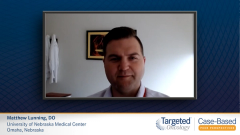
Case Review of a 71-Year-Old Woman Presenting With DLBCL
Matthew Lunning, DO, presents a case of a 71-year-old woman with relapsed/refractory diffuse large B-cell lymphoma and discusses considerations for therapy.
Matthew Lunning, DO: Welcome everybody. I’m Matt Lunning. I’m an associate professor at the University of Nebraska Medical Center here in Omaha. I want to take the time to thank you for joining us today as we go through a case of a 71-year-old woman with relapsed diffuse large B-cell lymphoma. We’ll discuss updates and thoughts on management of relapsed/refractory disease large B-cell lymphoma. This patient presented with fatigue, weight loss, and pruritus. She had a history of hypertension, which was medically controlled. On physical examination she had palpable axillary and femoral lymphadenopathy and the feeling of a spleen at 3 cm below the midclavicular line. She had a pretty good performance status, deemed a level of 1.
This patient had a clinical work-up that included a hemoglobin of 9.8 g/dL, an LDH [lactate dehydrogenase] that was 2 times the upper limit of normal, and her renal and hepatic function were with the normal limits. She had an infectious evaluation, with a normal hepatitis B, C, and HIV test. She then underwent an excisional biopsy of a right enlarged axillary lymph node. This demonstrated diffuse large B-cell lymphoma, germinal center B-cell subtype. The atypical lymphocytes were positive on immunochemistry for CD10 and CD20. FISH [fluorescent in situ hybridization]analysis demonstrated a translocation in chromosomes 14;18 consistent with a BCL2 rearrangement. There was no evidence of MYC or BCL2 rearrangement. Flow cytometry on the initial specimen was also positive for CD19.
She then underwent further staging with a whole-body PET [positron emission tomography]/CT showing FDG [fluorodeoxyglucose] avidity in the bilateral axillary and femoral regions. The largest lymph node was 3.6 cm in the right axillary space, and there was evidence of splenomegaly. Given the findings of the anemia but no evidence of bone avidity, she did undergo a bone marrow biopsy. This did demonstrate involvement of diffuse large B-cell lymphoma. Given these findings the patient had an Ann Arbor system stage of IVA diffuse large B-cell lymphoma, germinal center B-cell subtype. Her IPI [International Prognostic Index] score was felt to be high risk.
Given the findings—immediately diagnosed diffuse large B-cell lymphoma that did not harbor a double or a triple hit—she was treated with R-CHOP [rituximab, cyclophosphamide, doxorubicin, vincristine, prednisone] for a total of 6 cycles. At the end of treatment her PET/CT was unremarkable, and she achieved a metabolic complete remission based upon the Deauville score. Unfortunately, 9 months later on physical exam there was finding of new cervical lymphadenopathy. Further imaging demonstrated not only the cervical lymphadenopathy but mediastinal lymphadenopathy. She subsequently underwent a core needle biopsy of a cervical lymph node that confirmed relapse of diffuse large B-cell lymphoma, germinal center B-cell subtype.
At this time, given her tolerance to R-CHOP [rituximab, cyclophosphamide, doxorubicin, vincristine, prednisone], a discussion did occur around whether she would like to proceed to second-line therapy with an intent to consolidate with an autologous stem cell transplant. After much discussion, the patient deferred second-line intensive therapy and auto transplant in lieu of further therapy. Therefore, she was felt to not be transplant eligible, given personal choice. She was started on tafasitamab and lenalidomide as a second line of therapy.
Transcript edited for clarity.
Case: A 71-Year-Old Woman with R/R DLBCL
Initial presentation
- A 71-year-old woman presented with fatigue, weight loss and pruritus
- PMH: HTN, medically controlled
- PE: palpable axillary and femoral lymphadenopathy; palpable spleen 3 cm below the midclavicular line
- ECOG PS 1
Clinical Workup
- Labs: Hb 9.8 g/dL, LDH 2x ULN; renal and hepatic function WNL
- Hepatitis B, C and HIV negative
- Excisional biopsy of a right enlarged axillary lymph node confirmed DLBCL, GCB subtype
- IHC positive for: CD10, CD20
- FISH panel: t(14;18) translocation with BCL2 rearrangement, no MYC or BCL2 rearrangements
- Flow cytometry: CD19-postitive
- Whole body PET/CT scan showed FDG avidity in the bilateral axillary and femoral regions, largest lymph node 3.6 cm in right axillary space; splenomegaly
- Bone marrow biopsy showed involvement of DLBCL in the bone marrow
- Ann Arbor stage IVa DLBCL, GCB subtype
- IPI score high-risk
Treatment
- Treated with R-CHOP x 6 cycles
- First post-treatment PET/CT scan unremarkable; metabolic CR based on Deauville criteria
- 9 months later there was relapse of disease with new cervical and mediastinal lymphadenopathy
- Core needle biopsy of a cervical lymph node confirms a relapse of DLBCL, GCB subtype
- She was offered ASCT but deferred
- Initiated tafasitamab + lenalidomide










































